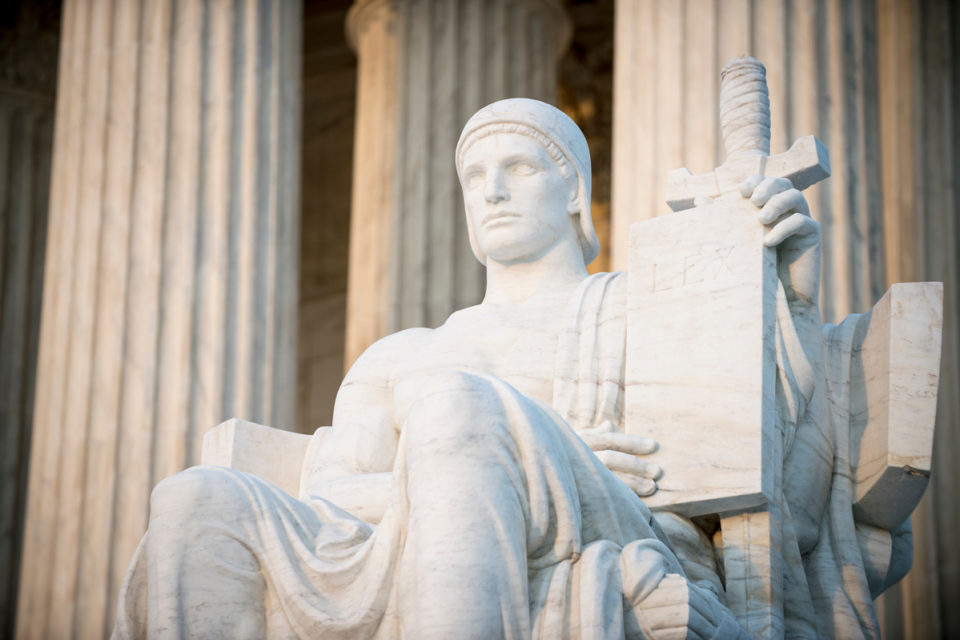West Virginia, et al. v. EPA – What It Is and What It Means for Continued Coal-Based Electrical Generation in the U.S.

By Paul M. Seby and Chris L. Bell, Greenberg Traurig LLP
On June 30, 2022, the Supreme Court of the United States issued its long-awaited decision in West Virginia, et al. v Environmental Protection Agency. By a 6-3 opinion written by Chief Justice John Roberts, the Court ruled in favor of the four petitioners, holding that the U.S. Environmental Protection Agency had exceeded the authority granted to it by Congress when EPA imposed greenhouse gas emissions (GHG) limits on existing coal-fueled power plants that could not be achieved, in order to force states and energy producers to shift generation to sources that emit fewer GHG emissions. Declining to opine on climate change or a variety of broad policy issues, the Court held: “That the only interpretive question before us, and the only one we answer, is more narrow: whether the ‘best system of emission reduction’ identified by EPA in the Clean Power Plan was within the authority granted to the Agency in Section 111(d) of the Clean Air Act. For the reasons given, the answer is no.”
The Court stated: “Capping carbon dioxide emissions at a level that will force a nationwide transition away from the use of coal to generate electricity may be a sensible ‘solution to the crisis of the day’ New York v. United States, 505 U. S. 144, 187 (1992). But it is not plausible that Congress gave EPA the authority to adopt on its own such a regulatory scheme in Section 111(d). A decision of such magnitude and consequence rests with Congress itself, or an agency acting pursuant to a clear delegation from that representative body.”
A few observations bear mention. First, the GHG emission reduction targets established by the EPA regulation rejected by the Court – the 2015 Clean Power Plan (CPP) – had already been achieved by the coal-fueled electric power generation sector 10 years ahead of schedule without any federal GHG emission regulations (the CPP never having gone into effect). Second, the petitioners were not challenging whether EPA has the authority to regulate GHG emissions, but rather how it can be lawfully exercised, and the Court’s decision did not question EPA’s authority to regulate climate change-related emissions. Third, the hyperbole and concern that the Court might use this case as a vehicle to “dismantle the administrative state” was wrong and reflected a fundamental distrust of American democracy.
The Court’s application of the major-question doctrine simply means that unelected administrators in federal agencies cannot unilaterally discover and exercise sweeping new powers, such as EPA transforming the structure and operation of the nation’s electrical grid, unless the citizens’ elected representatives have considered and granted those new powers. Fourth, this case was not a hypothetical exercise looking for an advisory opinion from the Court: the petitioners asked the Court to exercise its routine appellate review authority over the D.C. Circuit’s decision which vacated the Affordable Clean Energy (ACE) Rule (which had rescinded and replaced the CPP).
This case was about EPA’s and the states’ relative authority to regulate GHG emissions. The State of North Dakota’s independent participation in this case emphasized the fact that Congress gave the states a primary role in regulating air emissions from existing power plants and that EPA cannot unilaterally impose major national requirements that cut states out of the process. The Supreme Court has described the CAA as “a model of cooperative federalism” spelling out the respective roles of EPA and the states. The DC Circuit decision vacating the ACE Rule, and adopting EPA’s reasoning in the CPP, dismantled Congress’ cooperative federalism framework. It ruled that EPA can effectively deprive the states of any meaningful role in regulating GHG emissions from existing power plants by imposing national emission standards set intentionally at levels that could not be met by existing coal-fueled power plants and thereby forcing fundamental structural and operational changes to the power grid. The Supreme Court overruled the D.C. Circuit’s decision.
EPA replaced the CPP with the ACE Rule in 2019, which was promptly challenged in the DC Circuit. North Dakota and West Virginia intervened on behalf of EPA, arguing that the ACE Rule correctly allocated the responsibility to regulate power plant emissions between EPA and the states as directed by Congress. The D.C. Circuit vacated the ACE Rule in January 2021, largely adopting EPA’s reasoning from the CPP Rule.
On October 29, 2021, the Supreme Court granted North Dakota’s petition for certiorari, along with those of West Virginia et al., North American Coal Corporation and Westmoreland Mining Company. North Dakota filed its own briefs, arguing that the D.C. Circuit incorrectly diminished its rights under the Clean Air Act and that the ACE Rule should be reinstated.
What the Court’s Decision Does
The Court ruled that while EPA could regulate GHG emissions from existing coal-fueled power plants in accordance with its authority under CAA §111d to establish “achievable” emission standards as part of the “best system of emission reduction” that has been “adequately demonstrated,” EPA could not, without express congressional authority, expand that limited authority to restructure the nation’s electric power grid. The CPP established national emission standards that were intentionally not “adequately demonstrated” for coal-fueled plants, having been set by EPA to force the closure of coal-fueled power plants to implement a “generation shifting” policy towards renewables (the Court noted that the standard set for existing coal-fueled power plants was stricter than that set by EPA for new coal-fueled power plants, just one example of the CPP’s unprecedented structure). The CPP also upended over 100 years of state and local control over the electric power grid, which is based on a dispatching system prioritizing the lowest cost power and would have imposed a national system based on dispatching power from sources with the lowest GHG emissions. The Court agreed that this “generation shifting” approach might be a “sensible solution” for decreasing GHG emissions but concluded that Section 111(d) of the Clean Air Act, which only allows EPA to establish controls on existing facilities that have been “adequately demonstrated,” does not give EPA the authority to take over the national grid and impose “generation shifting.”
The Court wrote that there are “extraordinary cases” in which “history and the breadth of the authority that [the agency] has asserted” and “economic and political significance” present the issues as a “major question” for which the Court must determine whether Congress intended to give agencies such broad authority. The Court held that EPA could not leverage its limited and infrequently used authority under Section 111(d) of the Clean Air Act allowing it to establish “adequately demonstrated” guidelines for states to use in setting emission standards for existing facilities into becoming an unprecedented regulator of the national grid that could impose “generation-shifting” requirements on states and power generators. While EPA can regulate GHG emissions under its traditional authorities it cannot, without express Congressional authority, overstep its Clean Air Act regulatory powers to be the nation’s power grid regulator.
What the Court’s Decision Does Not Do and What This Means for Coal-Based Electrical Generation
After West Virginia, et al., EPA can use its Clean Air Act authorities to regulate GHG emissions, whether from cars or coal-fueled power plants. What it cannot do is rely on Section 111(d) of the Clean Air Act to intentionally set GHG emission standards for existing coal-fueled power plants that EPA knows are not technically achievable, demonstrated or available (and indeed not even achievable by new coal-fueled plants) in an effort to shut that sector down.
Therefore, the Supreme Court’s decision does not change EPA’s long-standing Clean Air Act authorities, and it only reined EPA in when it attempted to leverage Section 111(d) of the Clean Air Act to accomplish what by EPA’s own admission was an “aggressive transformation” of the entire electricity sector by imposing a “transition to zero-carbon renewable energy sources.” Though that may be a “sensible solution” to reducing GHG emissions, the Court concluded that the authority to accomplish such an “aggressive transformation” could not be located in Section 111(d) of the Clean Air Act. That does not mean EPA and the states are suddenly without authority to reduce GHG emissions, or that the CPP was the only solution to reducing GHG emissions from the energy sector. Quite the opposite.
Despite this significant decision, coal-fueled power generation will face many challenges from the continued operation of the traditional aspects of the federal Clean Air Act and energy policies and state equivalents. Coal-based electrical generation will face continued pressure from EPA, states and non-governmental public interest groups under the Clean Air Act programs controlling traditional pollutants (e.g., oxides of sulfur and nitrogen), visibility in Class I areas, air toxics and limitations necessary to achieve national ambient air quality standards. Other regulations not directly related to air emissions, such as those regulating the disposal of coal ash or the temperature of discharges of cooling water, may also continue to drive up the costs of operating coal-fueled power plants and potentially decrease their economic viability.
EPA might also consider whether the creative use of other tools may allow it to regulate GHG emissions in a way that touches coal-fueled power plants. However, any creative or new use by EPA of long-standing Clean Air Act authorities to impose significant new GHG regulations with major economic consequences could face challenges based on the major-questions doctrine that the Court enunciated in the West Virginia, et al. case.
Paul M. Seby is a special assistant attorney general for the State of North Dakota. He and Chris Bell are shareholders with the law firm Greenberg Traurig LLP, which represents the State of North Dakota before the U.S. Supreme Court.








